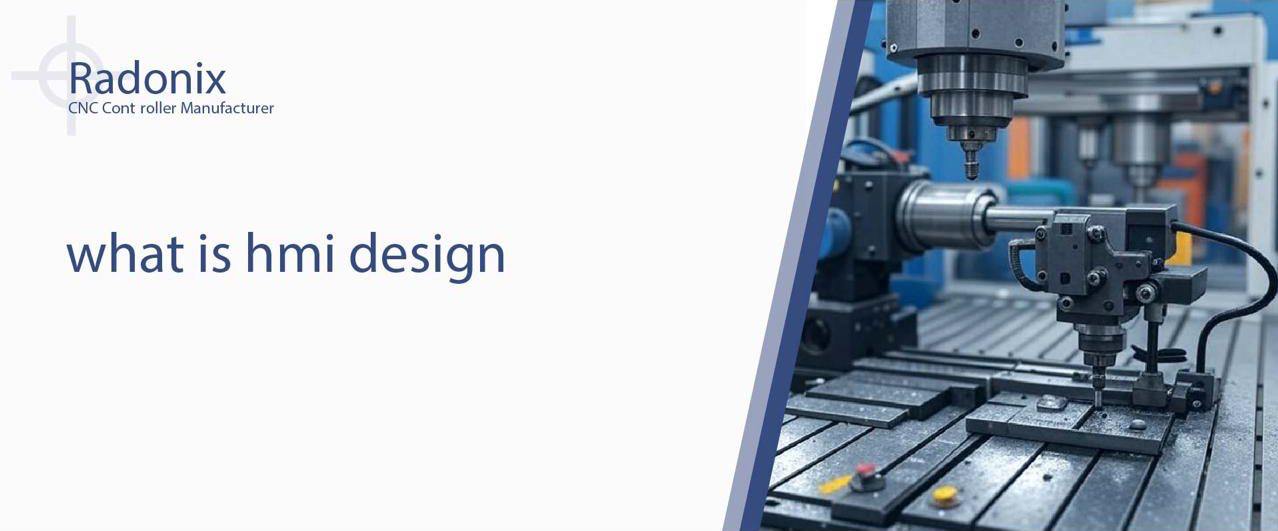In our technologically advanced world, we interact with complex systems every day, from the screen of our smartphone to the dashboard of our car.
But in the industrial sector, this interaction takes on a far more critical role. The connection between a machine and the person operating it is not a luxury; it’s a necessity for productivity and safety.
This critical link is known as the Human-Machine Interface, or HMI. So, what is HMI design, and why has it become such a pivotal topic in modern manufacturing?
HMI design is the process of creating the user interface and user experience for a machine.
It’s the visual dashboard, the control panel, and the communication system that allows an operator to monitor, control, and interact with a piece of equipment.
Far from being a simple afterthought, a well-executed HMI design is the key to unlocking a machine’s full potential. It can reduce errors, speed up production, and ensure the safety of personnel.
At Radonix, we specialize in providing the advanced control systems that power the most intuitive and robust HMIs on the market, and we are here to provide a detailed answer to the question, what is HMI design.
This article will serve as a comprehensive guide, breaking down the principles, components, and immense benefits of effective HMI design in an industrial context.
The Core Question: What is HMI Design?
At its simplest, HMI design is the discipline of creating a user-friendly and functional interface for an industrial device. It’s a blend of graphic design, cognitive psychology, and industrial engineering.
The goal of an HMI is to simplify complex operations, providing a clear and logical way for a human to manage a machine.
Instead of a confusing array of physical buttons, dials, and gauges, a modern HMI centralizes control into a digital, often touchscreen, interface. This allows an operator to:
- Monitor: View real-time data such as temperature, pressure, speed, and status.
- Control: Start, stop, or adjust a machine’s operations.
- Troubleshoot: Receive alerts, view diagnostic information, and respond to alarms.
The design must account for the operator’s environment (e.g., noise, dust, physical fatigue) and their skill level. The ultimate aim of HMI design is to make the machine’s operation as intuitive and error-free as possible, improving both efficiency and safety.
The Evolution of HMI: From Knobs to Intuitive Interfaces
To fully appreciate the importance of modern HMI design, it’s helpful to look at its evolution. Early industrial machines were controlled by physical buttons, switches, and mechanical gauges.
These interfaces were often complex, requiring extensive training and prone to human error. A different machine meant a completely new layout and a steep learning curve.
The advent of programmable logic controllers (PLCs) and digital screens changed everything.
HMIs evolved into graphical interfaces that could display a vast amount of information on a single screen. This transition brought greater functionality, but it also introduced a new challenge:
how to design a screen that is not just functional, but truly usable and effective.
The answer to “what is HMI design” today is a response to this challenge, focusing on clarity, simplicity, and a user-centric approach.
The Foundational Principles of Effective HMI Design
The best HMI designs are not created by chance. They are the result of a deliberate process guided by a set of core principles. These principles are the practical answer to the question, What is HMI design.
1. User-Centricity and Context
The user is at the center of the design process. A good HMI designer understands the operator’s tasks, their cognitive abilities, and the environment they work in. This involves:
- Task Analysis: What are the most common tasks? What information does the operator need most often?
- Environmental Factors: Will the operator be wearing gloves? Is the screen in a bright or dark area?
- Cognitive Load: The interface should not overwhelm the user with too much information at once. It should present information in a hierarchical and logical manner.
2. Clarity and Simplicity
Clarity is paramount. Every element on the screen should have a clear and unambiguous purpose.
- Visual Hierarchy: The most critical information (e.g., an alarm) should be the most prominent.
- Consistent Visuals: Use a consistent color scheme, font, and icon style throughout the interface to build familiarity and reduce the learning curve.
- Simple Icons: Icons should be simple, recognizable, and self-explanatory.
3. Real-time Feedback and Data Visualization
An operator needs immediate feedback on the state of the machine.
- Instant Confirmation: When a button is pressed, the HMI should provide immediate visual feedback.
- Data Visualization: A long list of numbers is harder to interpret than a simple graph or a color-coded diagram. Effective HMI design uses charts and animations to transform complex data into easily digestible information.
4. Ergonomics and Safety
HMI design also extends to physical interaction and safety.
- Accessibility: Buttons and menus should be easy to reach and big enough to be used with a gloved hand.
- Alarm Management: A robust alarm system is crucial. It should prioritize alarms, provide clear instructions for resolution, and log all events for future analysis.
Key Components and Features of Modern Design
Modern HMI design is defined by its powerful features, which go beyond simple data display.
- Intuitive Navigation: A logical menu structure with clear labels and a consistent layout makes it easy for operators to find the information they need quickly.
- Customizable Dashboards: The ability to customize dashboards allows an operator to prioritize the data most relevant to their specific tasks, improving efficiency.
- Advanced Alarm Management: A sophisticated alarm system not only alerts the operator but also provides diagnostic information, suggesting a likely cause and a recommended course of action.
- Data Logging and Reporting: HMIs can log all events, alarms, and production data. This information is invaluable for troubleshooting, process optimization, and creating detailed reports for quality control.
- IIoT Connectivity: A modern HMI is designed to be part of a larger network (the Industrial Internet of Things). This allows for remote monitoring, data sharing with other systems (MES/ERP), and even machine control from a central location.
Why HMI Design is a Strategic Advantage for Businesses
The benefits of a well-designed HMI are not just theoretical; they have a tangible impact on a company’s bottom line.
- Increased Productivity: A user-friendly HMI reduces setup time, speeds up operations, and allows operators to make quicker, more informed decisions.
- Enhanced Safety: By providing clear, immediate warnings and intuitive controls, a good HMI helps prevent accidents and protects personnel.
- Reduced Operator Error: A well-designed interface guides the operator, making it difficult to make a mistake, which saves time, money, and materials.
- Simplified Training: A consistent and intuitive HMI reduces the learning curve for new employees, allowing them to become productive more quickly.
The Radonix Advantage: Your Partner in HMI Design
At Radonix, we believe that the best HMI is one that seamlessly empowers the user. Our expertise lies in providing the core technology that powers these advanced interfaces.
We specialize in:
- Custom HMI Solutions: We work closely with our clients to design and implement HMIs that are perfectly tailored to their specific machines and applications.
- Robust and Reliable Systems: Our hardware is built for the demanding industrial environment, ensuring a reliable, long-lasting solution.
- Powerful and Intuitive Software: We provide the software backbone that offers advanced data visualization, robust alarm management, and seamless connectivity.
The answer to what HMI design is is that it’s a strategic investment in the future of your manufacturing operations. It is the key to creating a smarter, safer, and more productive factory.
Ready to design an HMI that transforms your operations? Contact Radonix today to learn how our advanced solutions can help you create a superior human-machine interface.
Contact Us:
- E-Mail: info@radonix.com
- Phone: +90 (553) 920 5500








